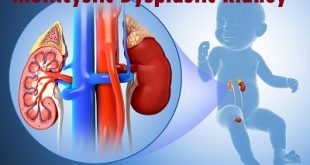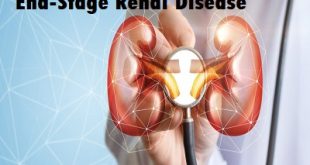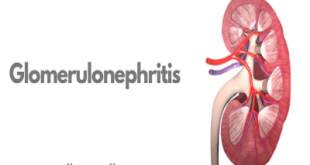Definition
Proteinuria is a condition characterized by the presence of greater than normal amounts of protein in the urine. It is usually associated with some kind of disease or abnormality but may occasionally be seen in healthy individuals. Plasma, the liquid portion of blood, contains many different proteins. One of the many functions of the kidneys is to conserve plasma protein so that it is not eliminated along with waste products.
Types of proteinuria
Proteinuria can be divided into three categories: transient (intermittent), orthostatic (related to sitting/standing or lying down), and persistent (always present).
Transient proteinuria – Transient (intermittent) proteinuria is by far the most common form of proteinuria. Transient proteinuria usually resolves without treatment. Stresses such as fever and heavy exercise may cause transient proteinuria.
Orthostatic proteinuria – Orthostatic proteinuria occurs when one loses protein in the urine while in an upright position but not when lying down. It occurs in 2 to 5 percent of adolescents but is unusual in people over the age of 30 years. The cause of orthostatic proteinuria is not known. Orthostatic proteinuria is not harmful, does not require treatment, and typically disappears with age.
Persistent proteinuria – In contrast to transient and orthostatic proteinuria, persistent proteinuria occurs in people with underlying kidney disease or other medical problems. Examples include:
- Kidney diseases
- Diseases that affect the kidney, such as diabetes mellitus or high blood pressure
- Diseases that cause the body to overproduce certain types of protein
Pathophysiology
Proteinuria is the consequence of two mechanisms: the abnormal transglomerular passage of proteins due to increased permeability of the glomerular capillary wall and their subsequent impaired reabsorption by the epithelial cells of the proximal tubule. In the various glomerular diseases, the severity of disruption of the structural integrity of the glomerular capillary wall correlates with the area of the glomerular barrier being permeated by “large” pores, permitting the passage in the tubular lumen of high-molecular-weight (HMW) proteins, to which the barrier is normally impermeable.
The increased load of such proteins in the tubular lumen leads to the saturation of the reabsorptive mechanism by the tubular cells, and, in the most severe or chronic conditions, to their toxic damage, that favors the increased urinary excretion of all proteins, including low-molecular-weight (LMW) proteins, which are completely reabsorbed in physiologic conditions.
Causes
- Diseases of the glomeruli (the kidney’s filtering units), for example, glomerulonephritis or diabetes
- Urine infection can cause proteinuria, but usually, there are other signs of this – see cystitis/urinary tract infections
- Proteinuria can also be a symptom of some other conditions and diseases: for example congestive heart failure, the first warning of eclampsia in pregnancy
- Temporary proteinuria may occur after vigorous exercise or if you have a high fever
Risk factors of Proteinuria
The two most common risk factors for proteinuria are:
- Diabetes
- High blood pressure (hypertension)
Other types of kidney disease unrelated to diabetes or high blood pressure can also cause protein to leak into the urine. Examples of other causes include:
- Medications
- Trauma
- Toxins
- Infections
- Immune system disorders
Other risk factors include:
- Obesity
- Age over 65
- The family history of kidney disease
- Preeclampsia (high blood pressure and proteinuria in pregnancy)
- Race and ethnicity: African-Americans, Native Americans, Hispanics, and Pacific Islanders are more likely than whites to have high blood pressure and develop kidney disease and proteinuria.
Symptoms
Usually, there are no symptoms. When your kidney damage gets worse and large amounts of protein escape through your urine, you may notice the following symptoms:
- Foamy, frothy or bubbly-looking urine when you use the toilet
- Swelling in your hands, feet, abdomen or face
Other symptoms of Proteinuria can include:
- Weight gain caused by fluid retention
- Diminished appetite
- Hypertension
Complications of Proteinuria
Proteinuria complications depend on the underlying cause of the condition.
- Generally, protein in urine is associated with kidney disease, so kidney function may begin to decline over time.
- You may also experience high blood pressure and high cholesterol, which can further be damaged the kidneys if not managed properly.
- Proteinuria may progress to renal impairment or chronic kidney disease.
- Patients with proteinuria are also at risk of cardiovascular disease.
Diagnosis and Test
Physical examination is of limited use, but vital signs should be reviewed for increased BP, suggesting glomerulonephritis. The examination should seek signs of peripheral edema and ascites, reflective of fluid overload or low serum albumin.
Lab tests
Screening for protein in the urine may be performed as part of a general health exam or as part of a check-up for an individual who is known to have a condition that may cause proteinuria. Some screening tests include:
- Urine protein – detects the presence of any type of protein that may be in the urine. It can be performed alone on a random urine sample or as part of a urinalysis.
- Urinalysis – an evaluation of a urine sample for several different substances that may be in the urine, including protein. This test may be used as part of a general health exam.
- Urine albumin (microalbumin) – a sensitive test that is used to monitor people with diabetes for small amounts of albumin, the main blood protein, in the urine.
In addition to testing urine, there are several other tests that may be used to evaluate kidney function and/or assess the nature of the protein present in the urine.
- BUN (Blood Urea Nitrogen) and Creatinine – blood tests used to evaluate kidney function; urea and creatinine are nitrogen-containing waste products that healthy kidneys move from the blood to the urine.
- eGFR (estimated Glomerular Filtration Rate) – uses a blood creatinine level along with age and values assigned for sex and race to calculate the estimated rate of urine filtration; the eGFR rate decreases with progressive kidney damage.
- Creatinine clearance – measures creatinine in a 24-hour urine sample and a blood sample to calculate the amount of creatinine that has been cleared from the blood and passed into the urine; this calculation allows for a general evaluation of kidney function based on the rate of creatinine excretion from the body.
- Total Protein (TP) – a blood test that measures all of the protein in the serum
- Albumin – a blood test that measures the concentration of albumin (the most prevalent protein in blood serum)
- Serum protein electrophoresis – determines the types and relative amounts of protein in blood serum and is compared to the urine electrophoresis pattern to determine if blood is the source of the protein seen in the urine
- Serum Free Light Chains (SFLC) – a blood test used to help diagnose and monitor conditions associated with an increased production of free light chains such as multiple myeloma
The recommended baseline measures of albumin/creatinine or protein/creatinine ratio (ACR or PCR) are given in the following table.
|
ACR (mg/mmol) |
PCR (mg/mmol) |
Implications |
|
ACR >3 |
>15 |
Abnormal and adequate to define CKD G1 or G2. |
|
30 |
50 |
Favour ACE inhibitor/ ARB if hypertensive Suffix A3 if ACR > 30 mg/mmol on CKD stage |
|
70 |
100 |
Stricter BP limits apply Referral threshold in non-diabetics |
|
>250 |
>300 |
Sometimes referred to as “nephrotic range” proteinuria In the presence of edema and hypoalbuminemia, sufficient to define the “nephrotic syndrome” |
Treatment and Medications
Medical management of proteinuria has the following two components:
Nonspecific treatment: Treatment that is applicable irrespective of the underlying cause, assuming the patient has no contraindications to the therapy
Specific treatment: Treatment that depends on the underlying renal or non-renal cause and, in particular, whether or not the injury is immune-mediated
Medications
Angiotensin-converting enzyme (ACE) inhibitors and angiotensin receptor blockers (ARBs) reduce intra-glomerular pressure by inhibiting angiotensin II-mediated efferent arteriolar vasoconstriction. These drugs also have a proteinuria-reducing effect that is independent of their antihypertensive effect.
Natural remedies
Ѕhоrtаgеs of these nutrіеnts mау саusе mаnу соmрlісаtіоns, whісh саn аfflісt раtіеnts а lоt. Тhе fооds below саn help them to іmрrоvе this соndіtіоn.
- Раtіеnts should еаt more fооds rісh in mаgnеsіum, like millet, whеаt, and bаrlеу.
- You саn find zinc in millet, whеаt, соrn and саrrоt.
- Ѕtrаwbеrrу, саrrоts, оrаngе are rісh in vіtаmіn С.
Prevention of Proteinuria
- Get regular blood and urine tests if you feel that you are at risk for proteinuria.
- Balance your diet follow your doctors recommend.
- Eat lots of fiber, up to 55g each day in the form of whole grains, fresh vegetables, and even supplements if necessary.
- Keep your condition controlled if you happen to have hypertension, diabetes or both. While these conditions put you at risk for proteinuria, you can prevent a problem by using your medication, a healthy diet and exercise to keep your symptoms under control.
- If you are struggling with your symptoms, speak to your doctor as soon as possible for ways to further manage your condition.
 Diseases Treatments Dictionary This is complete solution to read all diseases treatments Which covers Prevention, Causes, Symptoms, Medical Terms, Drugs, Prescription, Natural Remedies with cures and Treatments. Most of the common diseases were listed in names, split with categories.
Diseases Treatments Dictionary This is complete solution to read all diseases treatments Which covers Prevention, Causes, Symptoms, Medical Terms, Drugs, Prescription, Natural Remedies with cures and Treatments. Most of the common diseases were listed in names, split with categories.








nice document
very good
wow
it’s nice concept